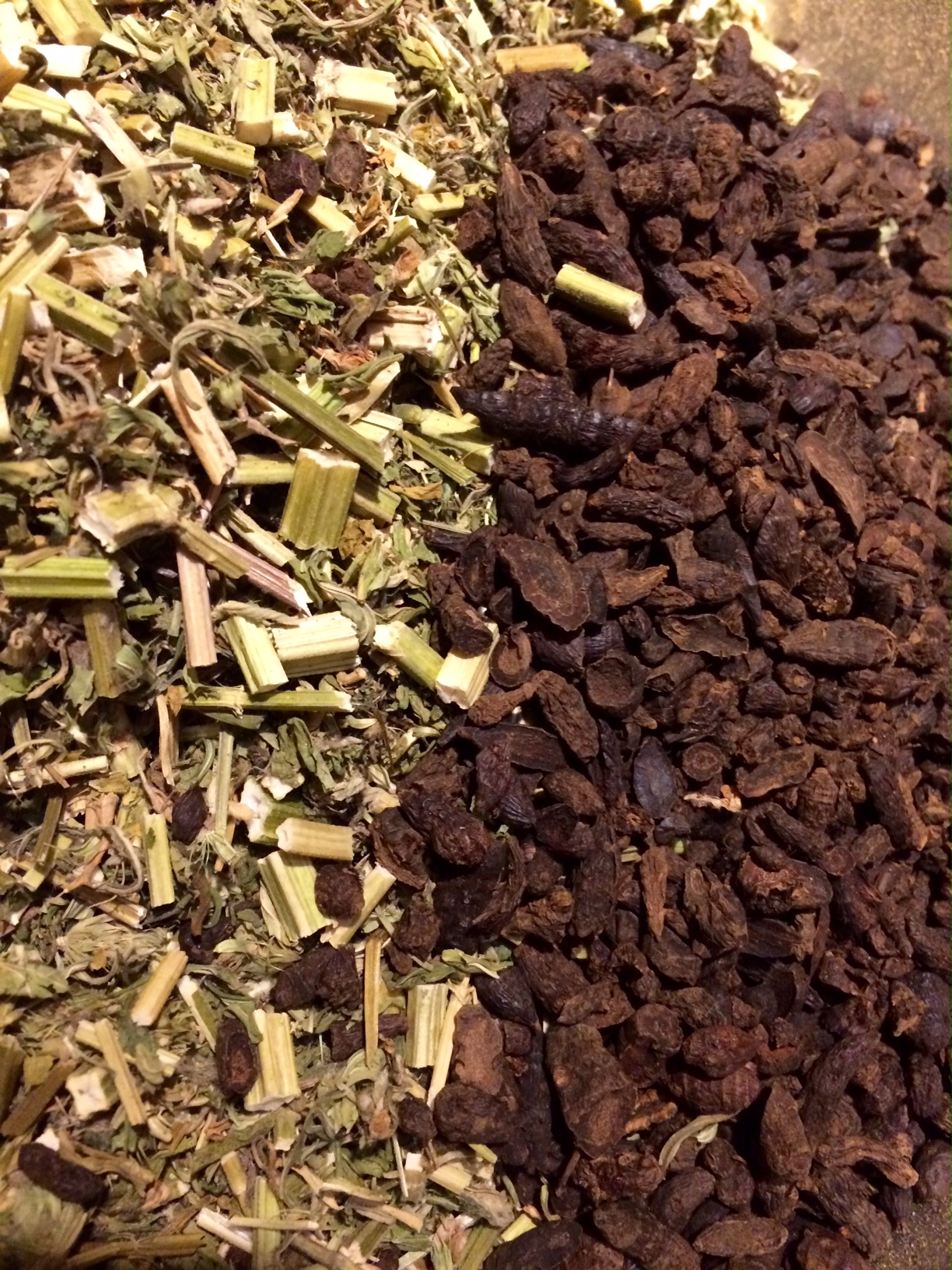In Chinese medicine, herbal medicines are combined together to create a custom mix of ingredients designed specifically for a patient’s needs. They may contain as few as 2 ingredients, or as many as 50 (I think I average somewhere between 8 to 16 ingredients in mine). Often a formula of herbs is built upon multiple pairs of herbs, called Dui Yao in Chinese, which have been shown, historically, to enhance and to strengthen the medicinal effect found in using just one herb alone. Kind of like the idea behind the ‘whole is greater than the sum of its parts’. Utilizing a team of helpers, rather than relying just one person, will obviously get any job done more efficiently.
Of course we mix culinary herbs together all the time when we cook. Can you imagine what pesto (my favorite sauce) would be like if we only used basil and no garlic! The combination makes the whole experience incredibly more delicious.
Even western pharmaceutical scientists understand that multiple ingredients mixed together can have a more powerful effect than using just one. From the British Journal of Pharmacology, I found the following quote in their december 2006 issue, ‘The development of systems biology has led to a new design principle for therapeutic intervention strategy, the concept of ‘magic shrapnel’ (rather than the ‘magic bullet’), involving many drugs against multiple targets, administered in a single treatment. Traditional Chinese Medicine (TCM) offers an extensive source of examples of this concept in which several active ingredients in one prescription are aimed at numerous targets and work together to provide therapeutic benefit.’
My teacher, Mazin Al Khafaji, who is considered a world leader for the treatment of dermatological, allergic, and auto-immune disease using Chinese medicine, is very fond of using herbs in pairs, and encourages all his students to learn the art. Below you can see a few photos, that I took this morning while preparing formulas for my patients, of some common herb pairs that have proved to be very beneficial time and time again.
Hong Hua (Safflower Flower) and Tao Ren (Peach Kernel)
These two herbs are commonly used together to help invigorate the flow of blood. I was using them today for a patient’s formula aimed at treating rosacea. In Chinese medicine we often find that rosacea is due to excessive heat that is scorching the blood and blood vessels, leading to blood stasis. Hence why a person’s complexion, with rosacea, will turn a deep purplish-red color, with prominent ‘spider veins’ (telangectasia) appearing. Herbs that cool the blood, as well as invigorate the flow of blood, can be very beneficial. In western medicine, rosacea is also seen as an inflammatory disease of the blood vessels.
Pi Pa Ye (Loquat Leaf) and Sang Bai Pi (Bark of Mulberry Root)
In Chinese medicine, a common cause for the more superficial forms of acne and rosacea is heat in the lung and stomach. These two herbs form an excellent pair to treat this.
Ji Xue Teng (Spatholobus, Millettia Root and Vine) and Dan Shen (Salvia Root)
In Chinese medicine, these two herbs are often used together to promote micro-circulation. I am using them today for a patient’s prescription aimed at clearing the hyper-pigmentation, or brown spots, left behind from acne (often referred to as an acne scar).
Chai Hu (Thorowax Root, Bupleurum) and Bai Shao Yao (White Peony Root)
This is a famous pair of herbs, being first seen combined together in some of the earliest known herbal formulations in Chinese medicine, dating back some 2000 years ago. Chai Hu is considered acrid, with an outward expanding nature, and Bai Shao is considered sour, with an inward contracting nature. As Mazin once said, the pair create a push-pull action, much like the wheels of a steam train, and are excellent at restoring a faulty Qi mechanism (i.e. a function of the body that may not be working very smoothly). In this prescription I am using the pair to help regulate a woman’s menstrual cycle which hasn’t been occurring in a monthly (28 day) fashion.
Xiang Fu (Nut Grass Rhizome) and Yi Mu Cao (Chinese Motherwort)
This is a famous pair of herbs used by Chinese medicine dermatologists to help treat skin conditions that flare up in a regular fashion before a woman’s menstruation. I am using them in the prescription I created today for a woman’s acne that always flares one week before her menstruation beings.
Herbal medicines are fun, beautiful and extremely powerful in treating a whole myriad of health concerns. I am grateful for the early path finders of Chinese medicine for figuring out how to use them properly! Many millions of people continue to receive benefit as a result.
Wishing you all good health,
Dr. Trevor Erikson





